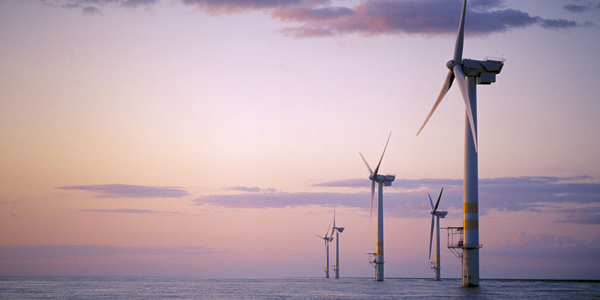By Liz Burdock
In his “Counterflow” column in the July 31 issue of RTO Insider, Steve Huntoon makes the unusual argument that because offshore wind costs more than onshore wind (i.e., requires more subsidies) offshore wind is a waste of money by a factor of 11:1 according to the Lazard study. Thus, we should build only onshore wind and forget about offshore wind.
However, there is plenty of evidence that offshore wind costs are rapidly coming down, and that some of offshore wind’s key benefits, especially its proximity to the population centers along the U.S. East Coast and job creation, make it a good value for ratepayers.
Mike O’Boyle, electricity policy manager for Energy Innovation, recently cited a Lawrence Berkeley National Laboratory (LBNL) study that showed “the high capacity factors of offshore wind, the coincidence of wind with customer demand, and the potential locations adjacent to congested coastal load centers like New York and Boston already make offshore wind an economic option.”
The LBNL study also found that the “market value” of offshore wind — considering energy, capacity and renewable energy certificates (RECs) — varies significantly along the U.S. East Coast, and “generally exceeds that of land-based wind in the region.”
The dramatic unveiling on Aug. 1 of the Massachusetts Department of Energy Resources’ 6.5-cents/kWh (in 2017 dollars) price for the Vineyard Wind project really brings this point home. In fact, the state estimates that Massachusetts electricity customers will see $1.4 billion in direct and indirect benefits over the 20-year life of the Vineyard Wind contract.
But there’s a larger problem with Mr. Huntoon’s claims that the Lazard study tells us that offshore wind is too expensive, and that the PJM territory has plenty of room for onshore wind. They center around transmission and distribution, which were “other factors” that were not included in the scope of the Lazard analysis. The simple fact is that most people don’t want to live near major electric transmission lines, which is why several transmission projects in New York and New England have been voted down by local and regional boards, and why New Jersey has virtually no onshore wind farms — and no plans to build any.
Several PJM states have a lot of land to build onshore wind; however, in coastal states like Maryland and New Jersey, the onshore wind resource is very small and as mentioned above difficult to site. According to the American Wind Energy Association, Maryland ranks 31st (191 MW) and New Jersey ranks 39th (9 MW) in installed onshore wind capacity. AWEA also estimates between 101 to 500 direct and indirect jobs are supported by onshore wind in both states.
Mr. Huntoon says the offshore wind jobs are a scam. It is hard to scam job creation when the Maryland Public Service Commission requires as a condition of the offshore renewable energy credit (OREC) order that US Wind and Skipjack invest $1.8 billion of in-state spending to spur the creation of almost 9,700 new direct and indirect jobs. Not only that, the two offshore wind developers must contribute $74 million in state tax revenues over 20 years.[1] Remember, those numbers must be met before one penny is paid to the developers. (OREC payments are not provided until the project is built and the offshore wind turbines are generating power.)
Mr. Huntoon is correct when he says, “It is critical that we make the most of our collective money” — a tenet the PSC understood when it decided to finance Maryland’s two offshore wind projects as a way to meet the state’s renewable portfolio standard and generate jobs. Maryland’s primary objective for its RPS is to foster the development of renewable energy resources within Maryland, but this goal has largely not been borne out.[2] Maryland’s data suggest that a significant portion of its REC costs paid for out-of-state onshore wind and solar. In fact, every year electricity suppliers in Maryland purchased greater numbers of out-of-state RECs to comply with the RPS. The Maryland Energy Administration (MEA) estimates that in 2015, Maryland ratepayers paid more than $76 million for RECs that were generated out-of-state. MEA estimates that as much as $186 million, if not more, has been spent to acquire non-Maryland RECs.[3] There is no in-state spending requirement, nor Maryland tax revenue generated, with these out-of-state projects — just millions of state ratepayer dollars going to other states. Isn’t that the real scam?
So, if we consider that offshore wind is a proven power producer in Northern Europe; offshore wind turbines are getting much bigger (see General Electric’s 12-MW turbine) and more productive than onshore turbines; offshore wind is stronger and more consistent than onshore wind; and offshore costs are coming down faster than anticipated, you can see why states like Massachusetts, New York, New Jersey and Maryland are counting so heavily on offshore wind. Yes, it’s going to take some upfront investment to establish the industry in the U.S., but those costs will be more than offset by the superior value provided by offshore wind over the next 20 to 30 years and beyond.
Liz Burdock is executive director of the Business Network for Offshore Wind.
- https://www.psc.state.md.us/wp-content/uploads/PSC-Awards-ORECs-to-US-Wind-Skipjack.pdf ↑
- Generating Clean Horizons was an effort to stimulate this goal because the RPS on its own did not result in clean electricity generation within the state. ↑
- http://news.maryland.gov/mea/2017/01/30/marylands-renewable-energy-portfolio-standard-an-insiders-perspective-what-you-should-know/ ↑




